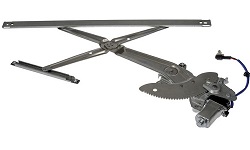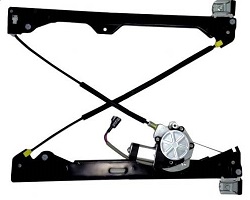There are Two Main Designs Of Window Regulators; Scissor Type and Cable Driven
Scissor type window regulators are an older design that you'll find mostly on classic vehicles. Built with virtually all metal components, a main arm is connected to the window carriage/tray on one end and to a large plate with gear teeth on the other. If a scissor type assembly is power operated, an electric motor turns a worm gear that meshes with those teeth to move the arms. In the absence of a power motor, a manual crank handle serves the same function.
The main arm is crossed by a smaller secondary arm at a hinged center point, and both arms slide on small wheels along a groove in the bottom of the window tray as they push the window up or pull it down. Scissor type regulators may fail when wheels at the ends of the arms wear out and break off - causing the glass to tilt at an angle inside the door. When the center hinge wears between the two bars as they scissor up and down, the whole mechanism makes noise and the glass will rattle in a sloppy unpredictable fashion.

Cable Type
Cable Type Cable-driven window regulators have become popular with automakers in recent decades because their compact size provides more room inside the door for safety beams and airbags, their lighter weight contributes to overall fuel economy, and the integrated assembly reduces manufacturing costs. However, they actually have more parts and are more complex than scissor type regulators.
Cable-driven regulators all feature a metal track (or tracks) mounted vertically inside the door panel that serve as a guide piece or pieces when the window tray slides up and down. Depending on design, some setups have one main regulator track in the center of the door, and other setups will have a track on each side of the glass. Window regulators with one center track typically feature two smaller guide rails along window edges to prevent window wobble during travel.
In cable type setups, an electric motor or manual crank moves wire cables which travel across a series of pulley wheels before connecting to a window tray or clamps. As the cables are pulled fore and aft, the window opens or closes. Cables suspend the full weight of your window, and if they (or the pulley wheels or even plastic window trays) break then the glass will fall unimpeded all the way down into your door panel and be stuck there.
Another weak spot of cable type regulator assemblies are pulley wheels that can become shredded if cables run over them at angles that are askew instead of perfectly straight - a condition that develops if guide rails become warped for any reason.
*Cable Style General Installation Instructions


You must login to post comments.